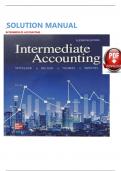Exam (elaborations)
Solution Manual For Intermediate Accounting, 11th Edition by David Spiceland, Mark Nelson|9781264134526|All Chapters 1-21|LATEST
- Course
- Institution
- Book
Solution Manual For Intermediate Accounting, 11th Edition by David Spiceland, Mark Nelson|9781264134526|All Chapters 1-21|LATEST
[Show more]




